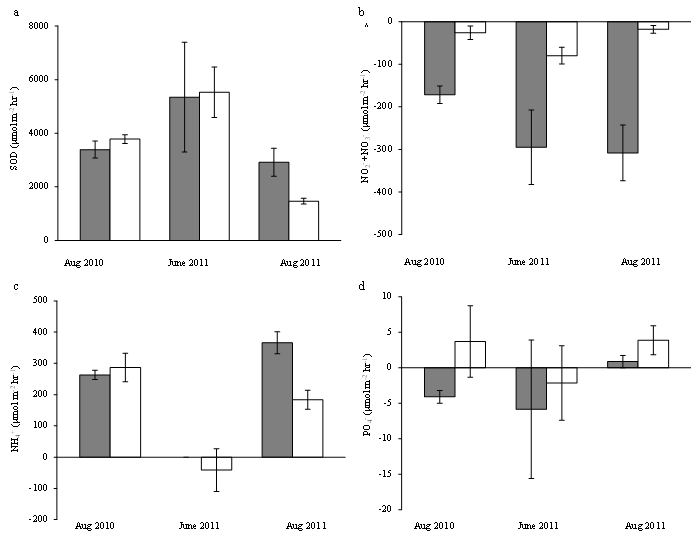Tidal Flat study
(Lead investigators: Fulweiler, Fagherazzi)
The research plan for the tidal flat study includes:
- In situ tidal flat manipulation experiments
- Tidal creeks experiments
- Currents and waves measurements
Tidal flat fertilization experiment
Although the erodability and stability of tidal flats depends on a variety of factors, we are most interested in the role of microphytobenthos, because they are a critical component to biofilms that inhabit the surface layer of tidal flats, play a crucial role in determining tidal flat stability and respond to increased nutrients. Microphytobenthos biomass exude a carbohydrate matrix that can alter substrate mechanical properties (e.g. critical shear stress for erosion) of tidal flats and decrease rates of erosion and sediment resuspension. The biofilm can also be rough and sticky, thus increasing hydraulic roughness and sediment deposition. One of our hypothesis is that chronic nutrient enrichment increases microphytobenthos biomass, and thus stabilizes and aggrades tidal flats.
In order to test this idea, we manipulated a portion of a mudflat surface, adding nutrients for a 14 days period.
 Location of the tidal flat fertilization experiment.
Location of the tidal flat fertilization experiment.
Results
1) Over the course of the experiment we observed an increase in the variable PAM fluorescence. This increase was more noticeable in the fertilized plots than in the control plots. We hypothesize that if fertilization were continued this increase may intensify due to a predicted increase in MPB biomass. The daily variability in sediment critical shear stresses was high. We hypothesize that the sediment was more stable on days of lower light, and therefore higher MPB activity. However on days where MPB activity was already low due to higher light levels the sediment strength was decreased.
2) Preliminary results suggest that we do not see a pronounced impact of fertilization on sediment oxygen demand, benthic inorganic nutrient fluxes, and net sediment N2 fluxes. However, these data are still being analyzed and need to be compared to geomorphological data that was simultaneously collected.
Tidal creel fertilization experiment
We also measured benthic metabolism in two tidal creeks in the Plum Island Sound LTER Tide project to assess how long-term fertilization impacted sediment oxygen demand and benthic nutrient fluxes.
Results
1) Rates of both net denitrification and nitrate uptake were significantly higher in the fertilized creek. Sediment oxygen demand was within the range of other marsh systems (1271.9 to 7855.0 mol m-2 hr-1) and was not significantly different between the two creeks. High rates of ammonium release from the sediment and a strong correlation between ammonium and nitrite fluxes suggest that dissimilatory nitrate reduction to ammonium (DNRA) was occurring in this system. Calculated rates of DNRA were significantly higher in the fertilized creek, and represented 49% and 22% of the total nitrate uptake in the fertilized and reference creeks, respectively. These results suggest that DNRA may outcompete denitrification at high nitrate concentrations. If this holds true then continued anthropogenic nitrogen loading may have a detrimental effect on the nitrogen removal capacity of salt marsh ecosystems.

